BUS1602 Global Business and Sustainability
VerifiedAdded on 2020/04/15
|13
|3888
|103
AI Summary
Contribute Materials
Your contribution can guide someone’s learning journey. Share your
documents today.
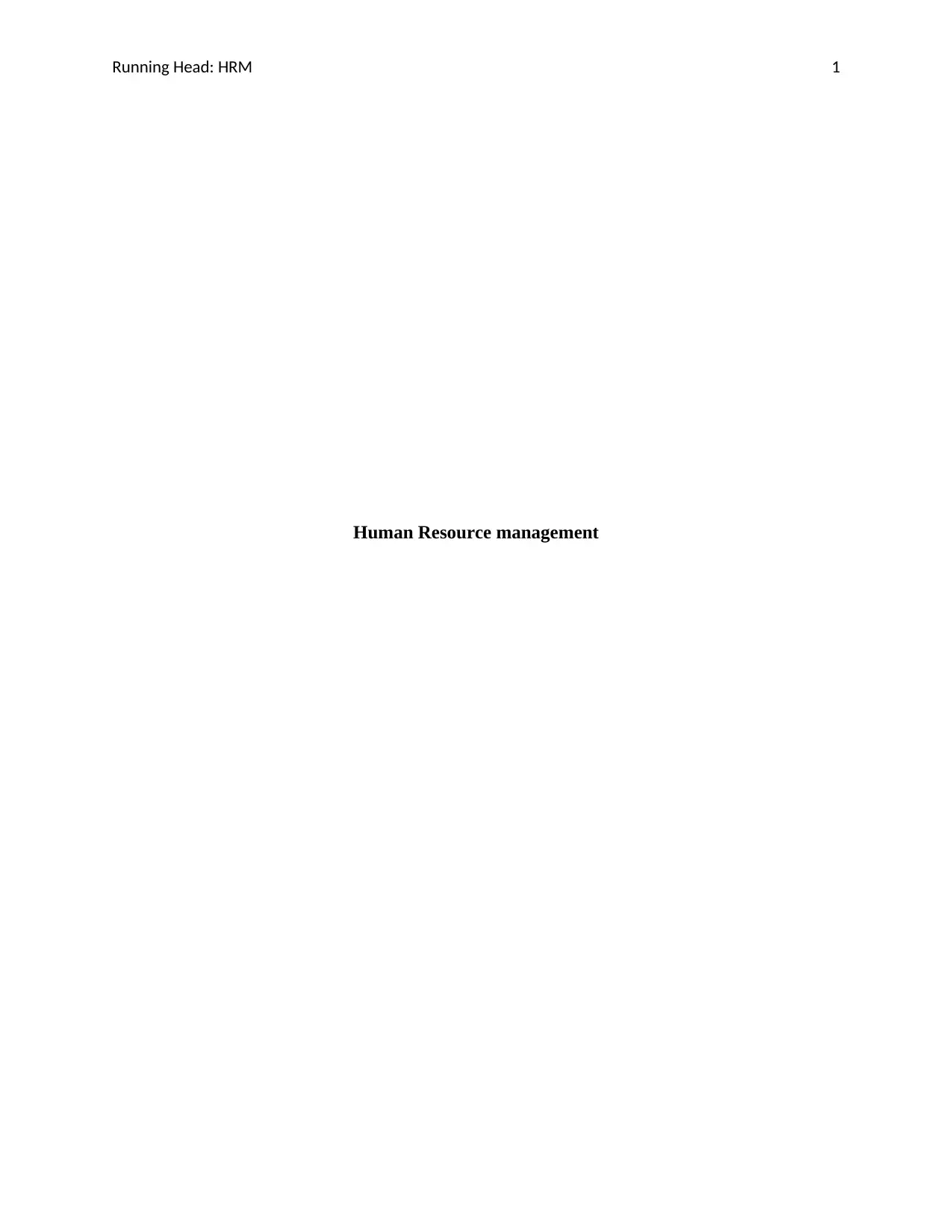
Running Head: HRM 1
Human Resource management
Human Resource management
Secure Best Marks with AI Grader
Need help grading? Try our AI Grader for instant feedback on your assignments.
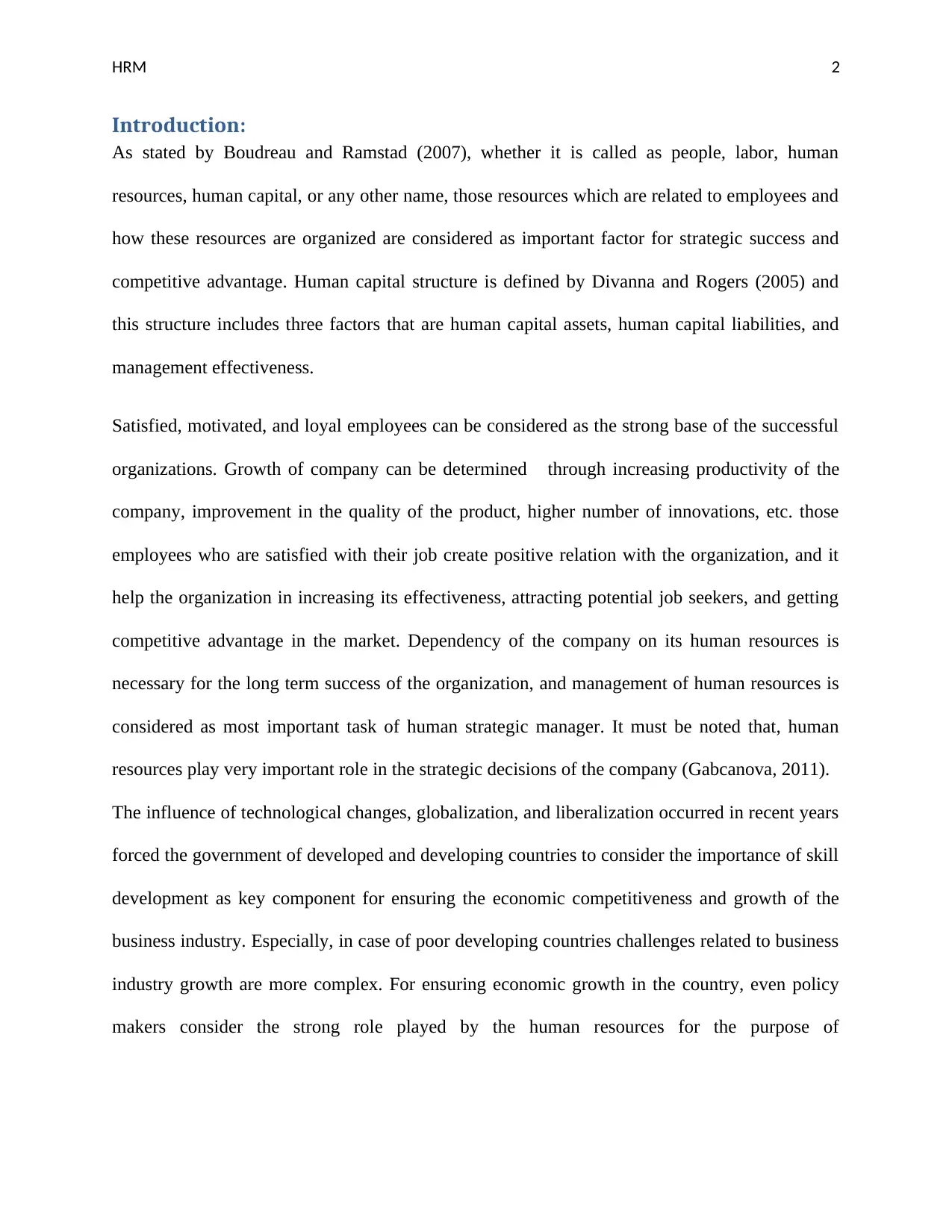
HRM 2
Introduction:
As stated by Boudreau and Ramstad (2007), whether it is called as people, labor, human
resources, human capital, or any other name, those resources which are related to employees and
how these resources are organized are considered as important factor for strategic success and
competitive advantage. Human capital structure is defined by Divanna and Rogers (2005) and
this structure includes three factors that are human capital assets, human capital liabilities, and
management effectiveness.
Satisfied, motivated, and loyal employees can be considered as the strong base of the successful
organizations. Growth of company can be determined through increasing productivity of the
company, improvement in the quality of the product, higher number of innovations, etc. those
employees who are satisfied with their job create positive relation with the organization, and it
help the organization in increasing its effectiveness, attracting potential job seekers, and getting
competitive advantage in the market. Dependency of the company on its human resources is
necessary for the long term success of the organization, and management of human resources is
considered as most important task of human strategic manager. It must be noted that, human
resources play very important role in the strategic decisions of the company (Gabcanova, 2011).
The influence of technological changes, globalization, and liberalization occurred in recent years
forced the government of developed and developing countries to consider the importance of skill
development as key component for ensuring the economic competitiveness and growth of the
business industry. Especially, in case of poor developing countries challenges related to business
industry growth are more complex. For ensuring economic growth in the country, even policy
makers consider the strong role played by the human resources for the purpose of
Introduction:
As stated by Boudreau and Ramstad (2007), whether it is called as people, labor, human
resources, human capital, or any other name, those resources which are related to employees and
how these resources are organized are considered as important factor for strategic success and
competitive advantage. Human capital structure is defined by Divanna and Rogers (2005) and
this structure includes three factors that are human capital assets, human capital liabilities, and
management effectiveness.
Satisfied, motivated, and loyal employees can be considered as the strong base of the successful
organizations. Growth of company can be determined through increasing productivity of the
company, improvement in the quality of the product, higher number of innovations, etc. those
employees who are satisfied with their job create positive relation with the organization, and it
help the organization in increasing its effectiveness, attracting potential job seekers, and getting
competitive advantage in the market. Dependency of the company on its human resources is
necessary for the long term success of the organization, and management of human resources is
considered as most important task of human strategic manager. It must be noted that, human
resources play very important role in the strategic decisions of the company (Gabcanova, 2011).
The influence of technological changes, globalization, and liberalization occurred in recent years
forced the government of developed and developing countries to consider the importance of skill
development as key component for ensuring the economic competitiveness and growth of the
business industry. Especially, in case of poor developing countries challenges related to business
industry growth are more complex. For ensuring economic growth in the country, even policy
makers consider the strong role played by the human resources for the purpose of
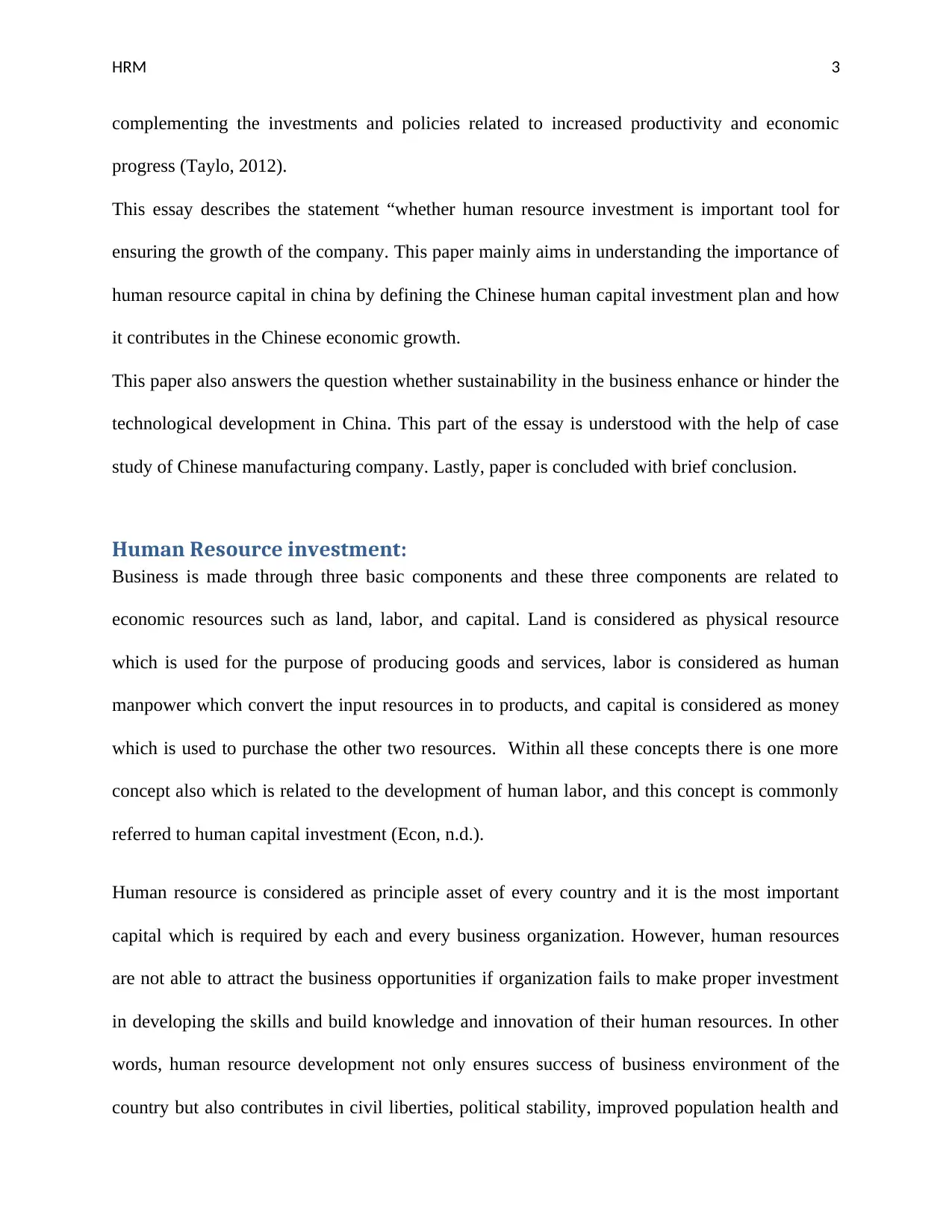
HRM 3
complementing the investments and policies related to increased productivity and economic
progress (Taylo, 2012).
This essay describes the statement “whether human resource investment is important tool for
ensuring the growth of the company. This paper mainly aims in understanding the importance of
human resource capital in china by defining the Chinese human capital investment plan and how
it contributes in the Chinese economic growth.
This paper also answers the question whether sustainability in the business enhance or hinder the
technological development in China. This part of the essay is understood with the help of case
study of Chinese manufacturing company. Lastly, paper is concluded with brief conclusion.
Human Resource investment:
Business is made through three basic components and these three components are related to
economic resources such as land, labor, and capital. Land is considered as physical resource
which is used for the purpose of producing goods and services, labor is considered as human
manpower which convert the input resources in to products, and capital is considered as money
which is used to purchase the other two resources. Within all these concepts there is one more
concept also which is related to the development of human labor, and this concept is commonly
referred to human capital investment (Econ, n.d.).
Human resource is considered as principle asset of every country and it is the most important
capital which is required by each and every business organization. However, human resources
are not able to attract the business opportunities if organization fails to make proper investment
in developing the skills and build knowledge and innovation of their human resources. In other
words, human resource development not only ensures success of business environment of the
country but also contributes in civil liberties, political stability, improved population health and
complementing the investments and policies related to increased productivity and economic
progress (Taylo, 2012).
This essay describes the statement “whether human resource investment is important tool for
ensuring the growth of the company. This paper mainly aims in understanding the importance of
human resource capital in china by defining the Chinese human capital investment plan and how
it contributes in the Chinese economic growth.
This paper also answers the question whether sustainability in the business enhance or hinder the
technological development in China. This part of the essay is understood with the help of case
study of Chinese manufacturing company. Lastly, paper is concluded with brief conclusion.
Human Resource investment:
Business is made through three basic components and these three components are related to
economic resources such as land, labor, and capital. Land is considered as physical resource
which is used for the purpose of producing goods and services, labor is considered as human
manpower which convert the input resources in to products, and capital is considered as money
which is used to purchase the other two resources. Within all these concepts there is one more
concept also which is related to the development of human labor, and this concept is commonly
referred to human capital investment (Econ, n.d.).
Human resource is considered as principle asset of every country and it is the most important
capital which is required by each and every business organization. However, human resources
are not able to attract the business opportunities if organization fails to make proper investment
in developing the skills and build knowledge and innovation of their human resources. In other
words, human resource development not only ensures success of business environment of the
country but also contributes in civil liberties, political stability, improved population health and
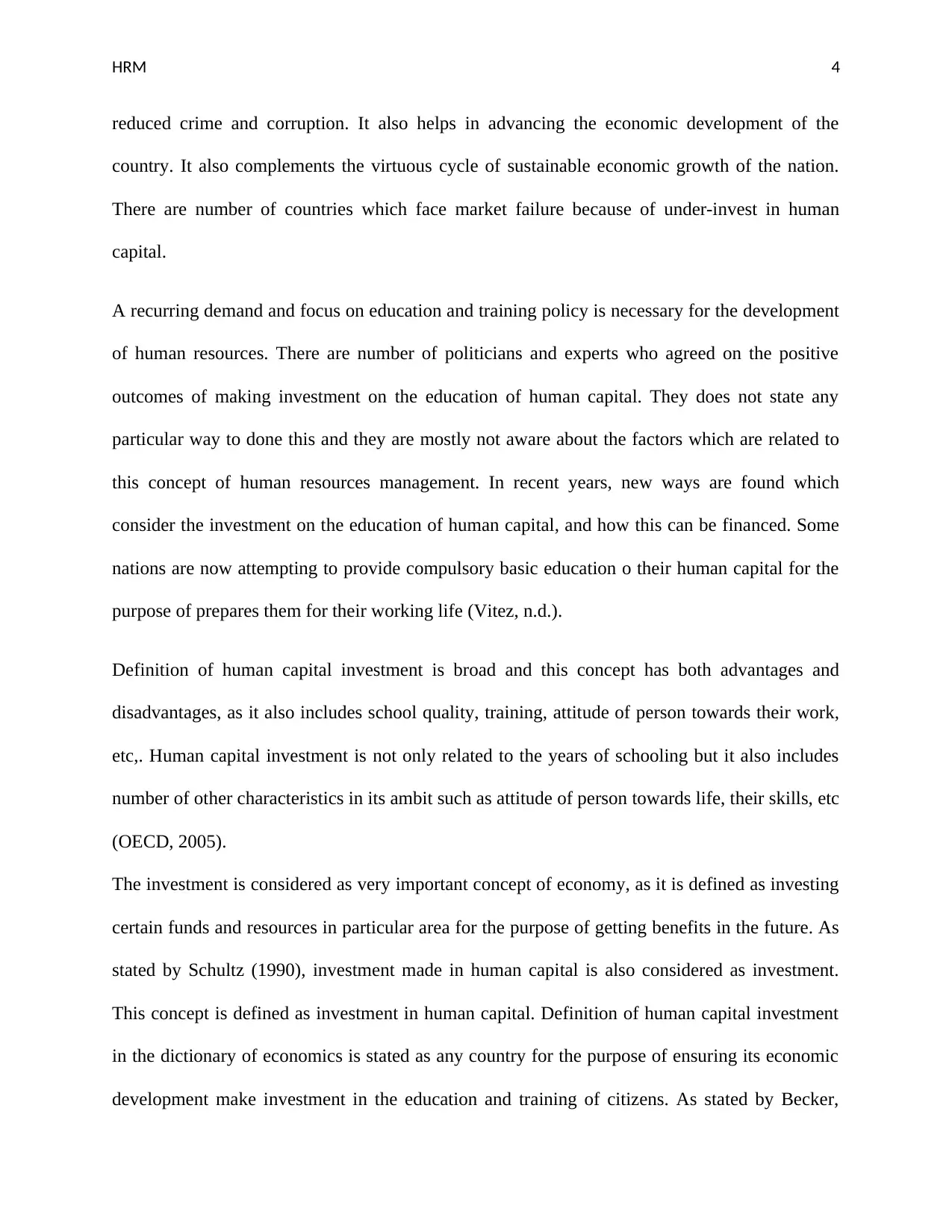
HRM 4
reduced crime and corruption. It also helps in advancing the economic development of the
country. It also complements the virtuous cycle of sustainable economic growth of the nation.
There are number of countries which face market failure because of under-invest in human
capital.
A recurring demand and focus on education and training policy is necessary for the development
of human resources. There are number of politicians and experts who agreed on the positive
outcomes of making investment on the education of human capital. They does not state any
particular way to done this and they are mostly not aware about the factors which are related to
this concept of human resources management. In recent years, new ways are found which
consider the investment on the education of human capital, and how this can be financed. Some
nations are now attempting to provide compulsory basic education o their human capital for the
purpose of prepares them for their working life (Vitez, n.d.).
Definition of human capital investment is broad and this concept has both advantages and
disadvantages, as it also includes school quality, training, attitude of person towards their work,
etc,. Human capital investment is not only related to the years of schooling but it also includes
number of other characteristics in its ambit such as attitude of person towards life, their skills, etc
(OECD, 2005).
The investment is considered as very important concept of economy, as it is defined as investing
certain funds and resources in particular area for the purpose of getting benefits in the future. As
stated by Schultz (1990), investment made in human capital is also considered as investment.
This concept is defined as investment in human capital. Definition of human capital investment
in the dictionary of economics is stated as any country for the purpose of ensuring its economic
development make investment in the education and training of citizens. As stated by Becker,
reduced crime and corruption. It also helps in advancing the economic development of the
country. It also complements the virtuous cycle of sustainable economic growth of the nation.
There are number of countries which face market failure because of under-invest in human
capital.
A recurring demand and focus on education and training policy is necessary for the development
of human resources. There are number of politicians and experts who agreed on the positive
outcomes of making investment on the education of human capital. They does not state any
particular way to done this and they are mostly not aware about the factors which are related to
this concept of human resources management. In recent years, new ways are found which
consider the investment on the education of human capital, and how this can be financed. Some
nations are now attempting to provide compulsory basic education o their human capital for the
purpose of prepares them for their working life (Vitez, n.d.).
Definition of human capital investment is broad and this concept has both advantages and
disadvantages, as it also includes school quality, training, attitude of person towards their work,
etc,. Human capital investment is not only related to the years of schooling but it also includes
number of other characteristics in its ambit such as attitude of person towards life, their skills, etc
(OECD, 2005).
The investment is considered as very important concept of economy, as it is defined as investing
certain funds and resources in particular area for the purpose of getting benefits in the future. As
stated by Schultz (1990), investment made in human capital is also considered as investment.
This concept is defined as investment in human capital. Definition of human capital investment
in the dictionary of economics is stated as any country for the purpose of ensuring its economic
development make investment in the education and training of citizens. As stated by Becker,
Secure Best Marks with AI Grader
Need help grading? Try our AI Grader for instant feedback on your assignments.
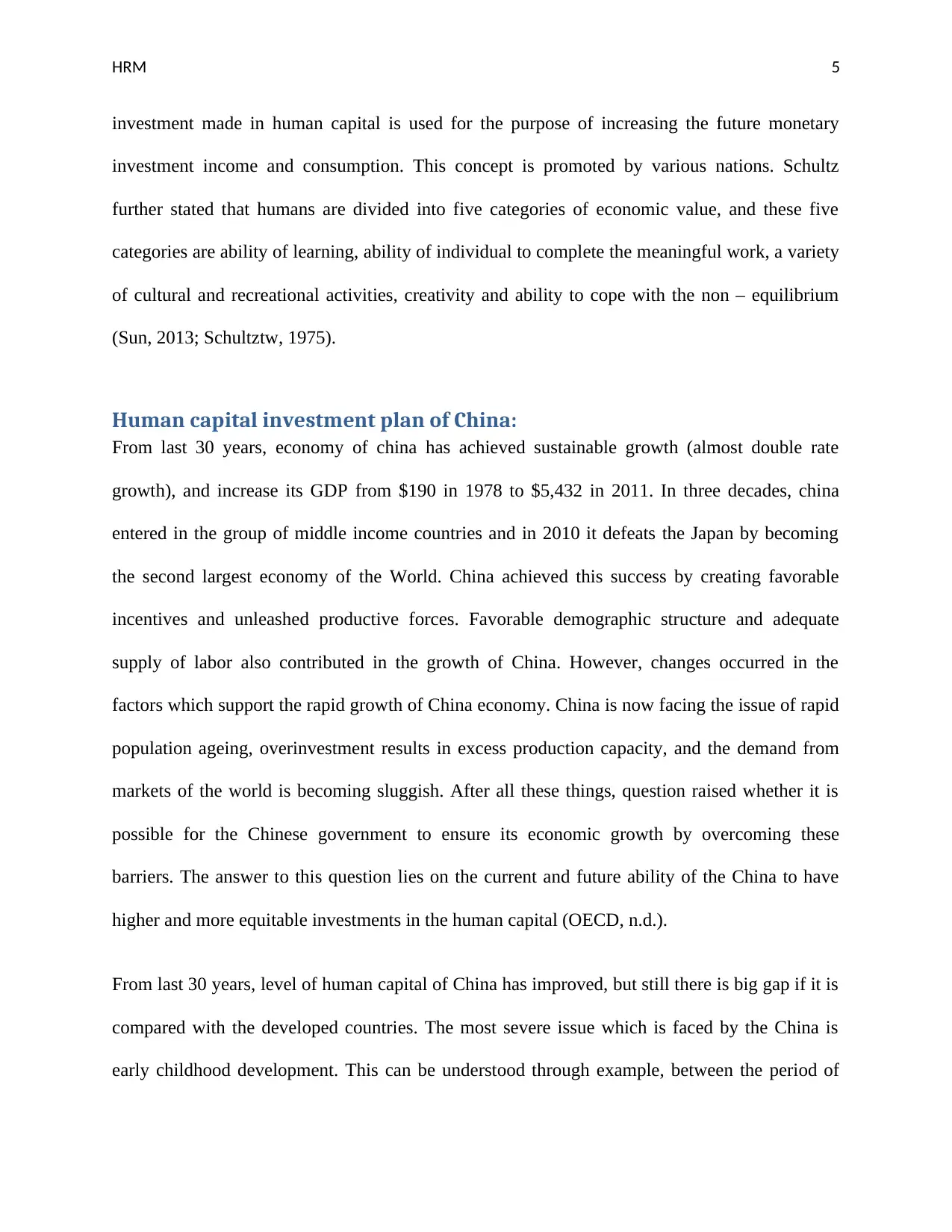
HRM 5
investment made in human capital is used for the purpose of increasing the future monetary
investment income and consumption. This concept is promoted by various nations. Schultz
further stated that humans are divided into five categories of economic value, and these five
categories are ability of learning, ability of individual to complete the meaningful work, a variety
of cultural and recreational activities, creativity and ability to cope with the non – equilibrium
(Sun, 2013; Schultztw, 1975).
Human capital investment plan of China:
From last 30 years, economy of china has achieved sustainable growth (almost double rate
growth), and increase its GDP from $190 in 1978 to $5,432 in 2011. In three decades, china
entered in the group of middle income countries and in 2010 it defeats the Japan by becoming
the second largest economy of the World. China achieved this success by creating favorable
incentives and unleashed productive forces. Favorable demographic structure and adequate
supply of labor also contributed in the growth of China. However, changes occurred in the
factors which support the rapid growth of China economy. China is now facing the issue of rapid
population ageing, overinvestment results in excess production capacity, and the demand from
markets of the world is becoming sluggish. After all these things, question raised whether it is
possible for the Chinese government to ensure its economic growth by overcoming these
barriers. The answer to this question lies on the current and future ability of the China to have
higher and more equitable investments in the human capital (OECD, n.d.).
From last 30 years, level of human capital of China has improved, but still there is big gap if it is
compared with the developed countries. The most severe issue which is faced by the China is
early childhood development. This can be understood through example, between the period of
investment made in human capital is used for the purpose of increasing the future monetary
investment income and consumption. This concept is promoted by various nations. Schultz
further stated that humans are divided into five categories of economic value, and these five
categories are ability of learning, ability of individual to complete the meaningful work, a variety
of cultural and recreational activities, creativity and ability to cope with the non – equilibrium
(Sun, 2013; Schultztw, 1975).
Human capital investment plan of China:
From last 30 years, economy of china has achieved sustainable growth (almost double rate
growth), and increase its GDP from $190 in 1978 to $5,432 in 2011. In three decades, china
entered in the group of middle income countries and in 2010 it defeats the Japan by becoming
the second largest economy of the World. China achieved this success by creating favorable
incentives and unleashed productive forces. Favorable demographic structure and adequate
supply of labor also contributed in the growth of China. However, changes occurred in the
factors which support the rapid growth of China economy. China is now facing the issue of rapid
population ageing, overinvestment results in excess production capacity, and the demand from
markets of the world is becoming sluggish. After all these things, question raised whether it is
possible for the Chinese government to ensure its economic growth by overcoming these
barriers. The answer to this question lies on the current and future ability of the China to have
higher and more equitable investments in the human capital (OECD, n.d.).
From last 30 years, level of human capital of China has improved, but still there is big gap if it is
compared with the developed countries. The most severe issue which is faced by the China is
early childhood development. This can be understood through example, between the period of
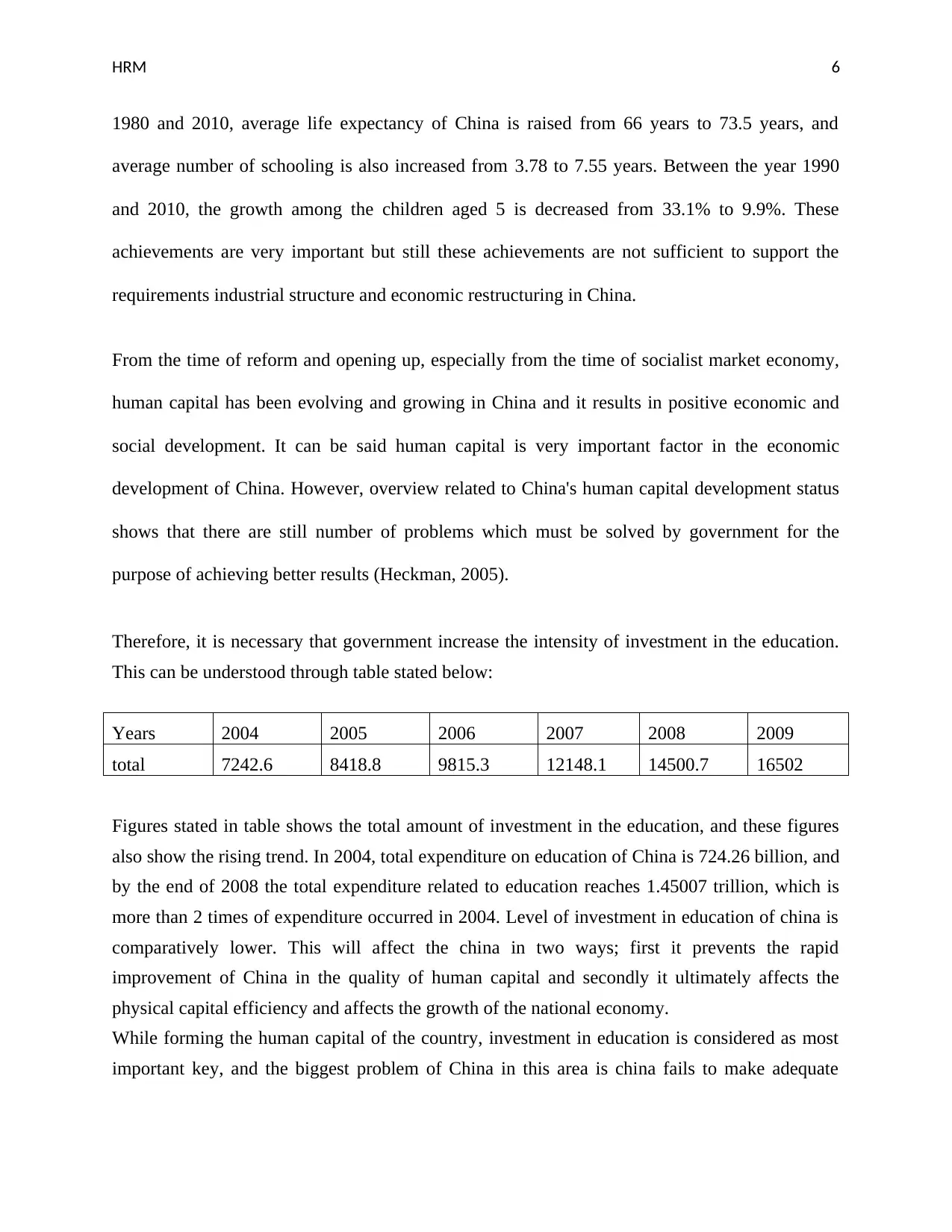
HRM 6
1980 and 2010, average life expectancy of China is raised from 66 years to 73.5 years, and
average number of schooling is also increased from 3.78 to 7.55 years. Between the year 1990
and 2010, the growth among the children aged 5 is decreased from 33.1% to 9.9%. These
achievements are very important but still these achievements are not sufficient to support the
requirements industrial structure and economic restructuring in China.
From the time of reform and opening up, especially from the time of socialist market economy,
human capital has been evolving and growing in China and it results in positive economic and
social development. It can be said human capital is very important factor in the economic
development of China. However, overview related to China's human capital development status
shows that there are still number of problems which must be solved by government for the
purpose of achieving better results (Heckman, 2005).
Therefore, it is necessary that government increase the intensity of investment in the education.
This can be understood through table stated below:
Years 2004 2005 2006 2007 2008 2009
total 7242.6 8418.8 9815.3 12148.1 14500.7 16502
Figures stated in table shows the total amount of investment in the education, and these figures
also show the rising trend. In 2004, total expenditure on education of China is 724.26 billion, and
by the end of 2008 the total expenditure related to education reaches 1.45007 trillion, which is
more than 2 times of expenditure occurred in 2004. Level of investment in education of china is
comparatively lower. This will affect the china in two ways; first it prevents the rapid
improvement of China in the quality of human capital and secondly it ultimately affects the
physical capital efficiency and affects the growth of the national economy.
While forming the human capital of the country, investment in education is considered as most
important key, and the biggest problem of China in this area is china fails to make adequate
1980 and 2010, average life expectancy of China is raised from 66 years to 73.5 years, and
average number of schooling is also increased from 3.78 to 7.55 years. Between the year 1990
and 2010, the growth among the children aged 5 is decreased from 33.1% to 9.9%. These
achievements are very important but still these achievements are not sufficient to support the
requirements industrial structure and economic restructuring in China.
From the time of reform and opening up, especially from the time of socialist market economy,
human capital has been evolving and growing in China and it results in positive economic and
social development. It can be said human capital is very important factor in the economic
development of China. However, overview related to China's human capital development status
shows that there are still number of problems which must be solved by government for the
purpose of achieving better results (Heckman, 2005).
Therefore, it is necessary that government increase the intensity of investment in the education.
This can be understood through table stated below:
Years 2004 2005 2006 2007 2008 2009
total 7242.6 8418.8 9815.3 12148.1 14500.7 16502
Figures stated in table shows the total amount of investment in the education, and these figures
also show the rising trend. In 2004, total expenditure on education of China is 724.26 billion, and
by the end of 2008 the total expenditure related to education reaches 1.45007 trillion, which is
more than 2 times of expenditure occurred in 2004. Level of investment in education of china is
comparatively lower. This will affect the china in two ways; first it prevents the rapid
improvement of China in the quality of human capital and secondly it ultimately affects the
physical capital efficiency and affects the growth of the national economy.
While forming the human capital of the country, investment in education is considered as most
important key, and the biggest problem of China in this area is china fails to make adequate
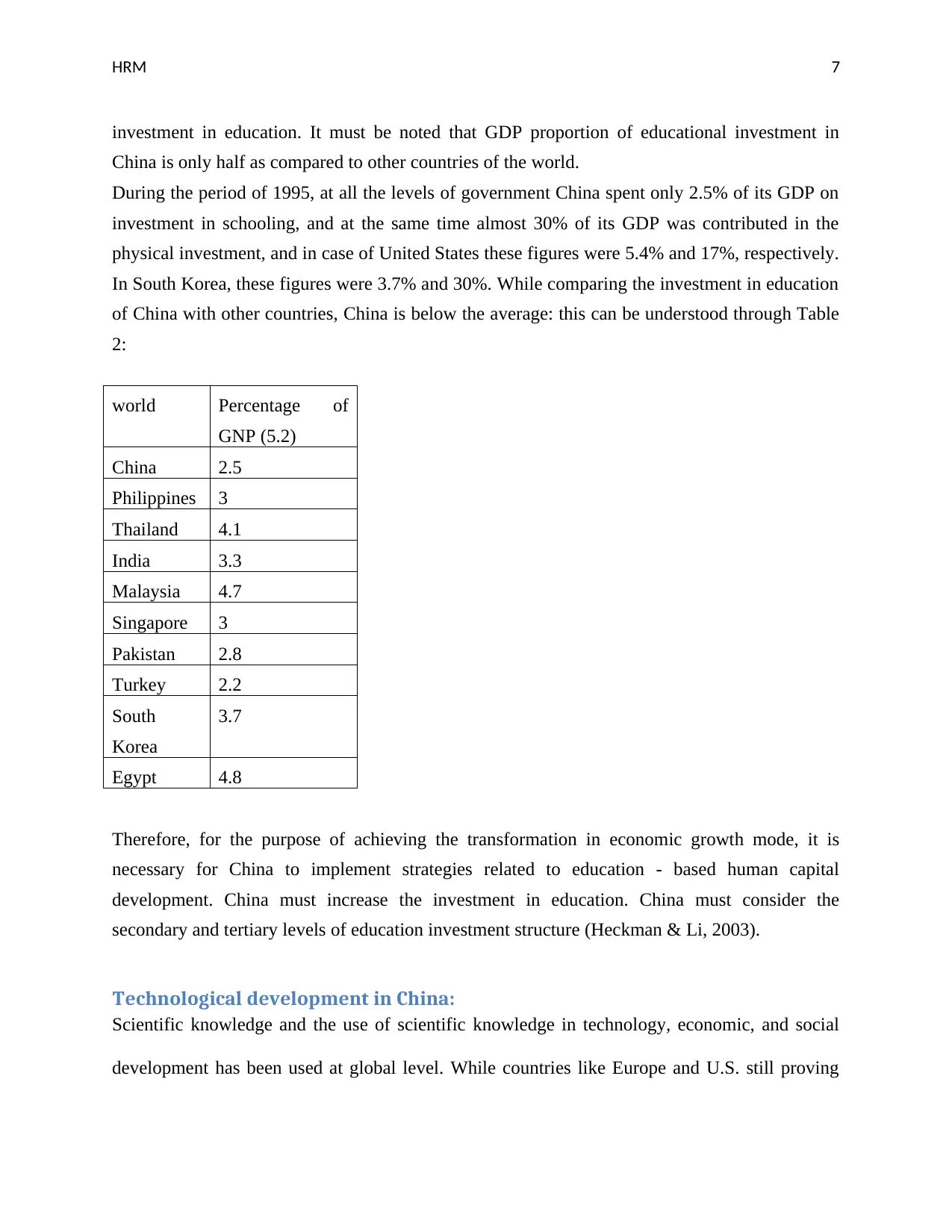
HRM 7
investment in education. It must be noted that GDP proportion of educational investment in
China is only half as compared to other countries of the world.
During the period of 1995, at all the levels of government China spent only 2.5% of its GDP on
investment in schooling, and at the same time almost 30% of its GDP was contributed in the
physical investment, and in case of United States these figures were 5.4% and 17%, respectively.
In South Korea, these figures were 3.7% and 30%. While comparing the investment in education
of China with other countries, China is below the average: this can be understood through Table
2:
world Percentage of
GNP (5.2)
China 2.5
Philippines 3
Thailand 4.1
India 3.3
Malaysia 4.7
Singapore 3
Pakistan 2.8
Turkey 2.2
South
Korea
3.7
Egypt 4.8
Therefore, for the purpose of achieving the transformation in economic growth mode, it is
necessary for China to implement strategies related to education - based human capital
development. China must increase the investment in education. China must consider the
secondary and tertiary levels of education investment structure (Heckman & Li, 2003).
Technological development in China:
Scientific knowledge and the use of scientific knowledge in technology, economic, and social
development has been used at global level. While countries like Europe and U.S. still proving
investment in education. It must be noted that GDP proportion of educational investment in
China is only half as compared to other countries of the world.
During the period of 1995, at all the levels of government China spent only 2.5% of its GDP on
investment in schooling, and at the same time almost 30% of its GDP was contributed in the
physical investment, and in case of United States these figures were 5.4% and 17%, respectively.
In South Korea, these figures were 3.7% and 30%. While comparing the investment in education
of China with other countries, China is below the average: this can be understood through Table
2:
world Percentage of
GNP (5.2)
China 2.5
Philippines 3
Thailand 4.1
India 3.3
Malaysia 4.7
Singapore 3
Pakistan 2.8
Turkey 2.2
South
Korea
3.7
Egypt 4.8
Therefore, for the purpose of achieving the transformation in economic growth mode, it is
necessary for China to implement strategies related to education - based human capital
development. China must increase the investment in education. China must consider the
secondary and tertiary levels of education investment structure (Heckman & Li, 2003).
Technological development in China:
Scientific knowledge and the use of scientific knowledge in technology, economic, and social
development has been used at global level. While countries like Europe and U.S. still proving
Paraphrase This Document
Need a fresh take? Get an instant paraphrase of this document with our AI Paraphraser
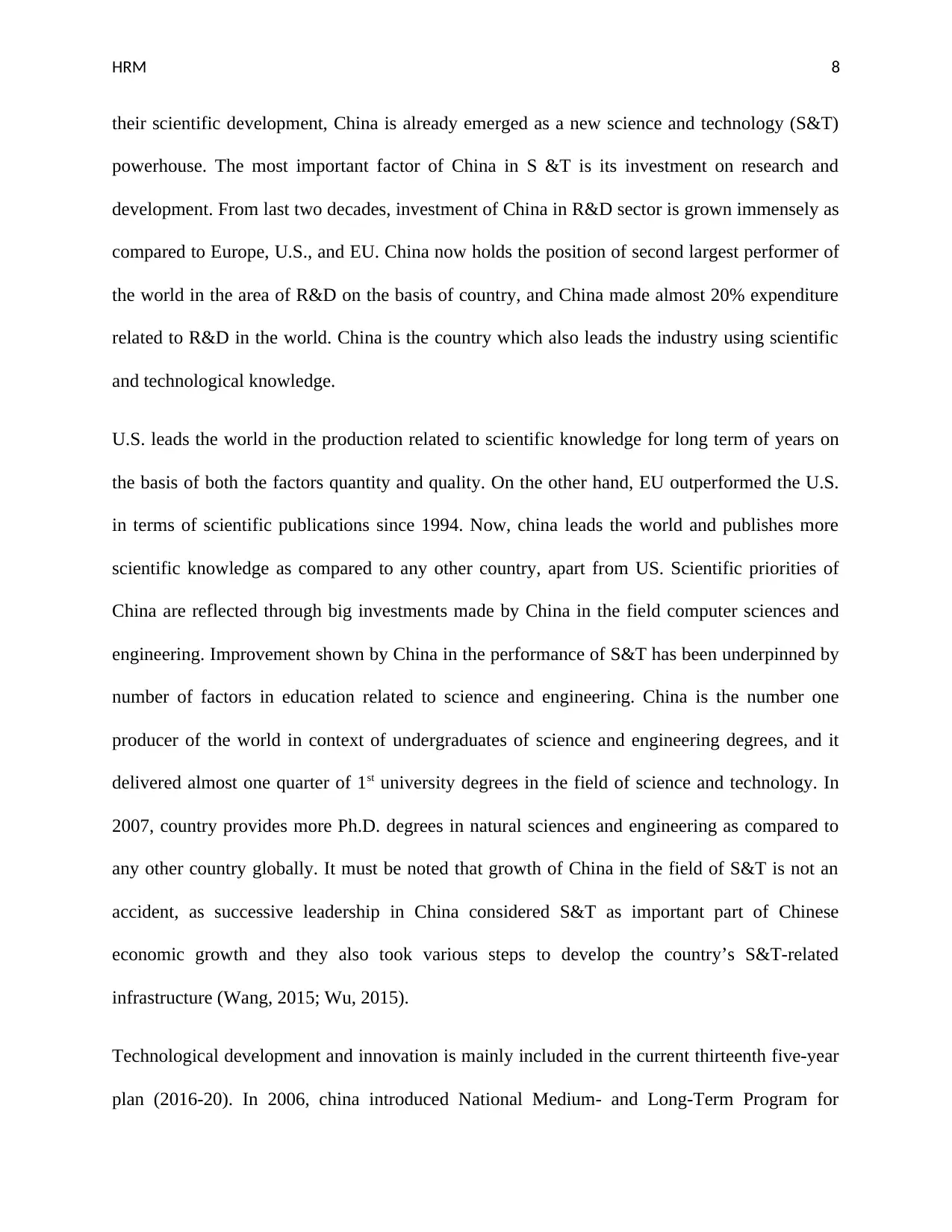
HRM 8
their scientific development, China is already emerged as a new science and technology (S&T)
powerhouse. The most important factor of China in S &T is its investment on research and
development. From last two decades, investment of China in R&D sector is grown immensely as
compared to Europe, U.S., and EU. China now holds the position of second largest performer of
the world in the area of R&D on the basis of country, and China made almost 20% expenditure
related to R&D in the world. China is the country which also leads the industry using scientific
and technological knowledge.
U.S. leads the world in the production related to scientific knowledge for long term of years on
the basis of both the factors quantity and quality. On the other hand, EU outperformed the U.S.
in terms of scientific publications since 1994. Now, china leads the world and publishes more
scientific knowledge as compared to any other country, apart from US. Scientific priorities of
China are reflected through big investments made by China in the field computer sciences and
engineering. Improvement shown by China in the performance of S&T has been underpinned by
number of factors in education related to science and engineering. China is the number one
producer of the world in context of undergraduates of science and engineering degrees, and it
delivered almost one quarter of 1st university degrees in the field of science and technology. In
2007, country provides more Ph.D. degrees in natural sciences and engineering as compared to
any other country globally. It must be noted that growth of China in the field of S&T is not an
accident, as successive leadership in China considered S&T as important part of Chinese
economic growth and they also took various steps to develop the country’s S&T-related
infrastructure (Wang, 2015; Wu, 2015).
Technological development and innovation is mainly included in the current thirteenth five-year
plan (2016-20). In 2006, china introduced National Medium- and Long-Term Program for
their scientific development, China is already emerged as a new science and technology (S&T)
powerhouse. The most important factor of China in S &T is its investment on research and
development. From last two decades, investment of China in R&D sector is grown immensely as
compared to Europe, U.S., and EU. China now holds the position of second largest performer of
the world in the area of R&D on the basis of country, and China made almost 20% expenditure
related to R&D in the world. China is the country which also leads the industry using scientific
and technological knowledge.
U.S. leads the world in the production related to scientific knowledge for long term of years on
the basis of both the factors quantity and quality. On the other hand, EU outperformed the U.S.
in terms of scientific publications since 1994. Now, china leads the world and publishes more
scientific knowledge as compared to any other country, apart from US. Scientific priorities of
China are reflected through big investments made by China in the field computer sciences and
engineering. Improvement shown by China in the performance of S&T has been underpinned by
number of factors in education related to science and engineering. China is the number one
producer of the world in context of undergraduates of science and engineering degrees, and it
delivered almost one quarter of 1st university degrees in the field of science and technology. In
2007, country provides more Ph.D. degrees in natural sciences and engineering as compared to
any other country globally. It must be noted that growth of China in the field of S&T is not an
accident, as successive leadership in China considered S&T as important part of Chinese
economic growth and they also took various steps to develop the country’s S&T-related
infrastructure (Wang, 2015; Wu, 2015).
Technological development and innovation is mainly included in the current thirteenth five-year
plan (2016-20). In 2006, china introduced National Medium- and Long-Term Program for
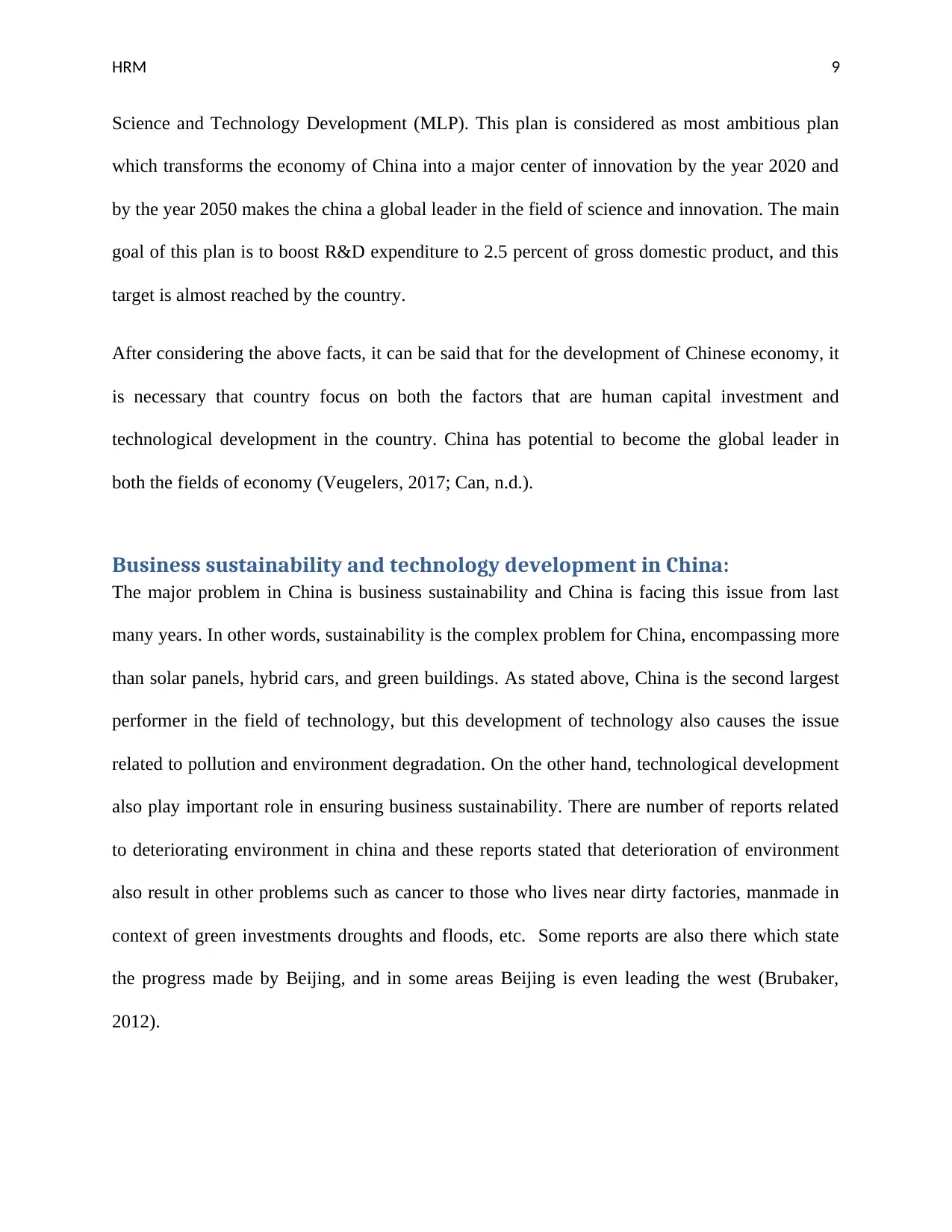
HRM 9
Science and Technology Development (MLP). This plan is considered as most ambitious plan
which transforms the economy of China into a major center of innovation by the year 2020 and
by the year 2050 makes the china a global leader in the field of science and innovation. The main
goal of this plan is to boost R&D expenditure to 2.5 percent of gross domestic product, and this
target is almost reached by the country.
After considering the above facts, it can be said that for the development of Chinese economy, it
is necessary that country focus on both the factors that are human capital investment and
technological development in the country. China has potential to become the global leader in
both the fields of economy (Veugelers, 2017; Can, n.d.).
Business sustainability and technology development in China:
The major problem in China is business sustainability and China is facing this issue from last
many years. In other words, sustainability is the complex problem for China, encompassing more
than solar panels, hybrid cars, and green buildings. As stated above, China is the second largest
performer in the field of technology, but this development of technology also causes the issue
related to pollution and environment degradation. On the other hand, technological development
also play important role in ensuring business sustainability. There are number of reports related
to deteriorating environment in china and these reports stated that deterioration of environment
also result in other problems such as cancer to those who lives near dirty factories, manmade in
context of green investments droughts and floods, etc. Some reports are also there which state
the progress made by Beijing, and in some areas Beijing is even leading the west (Brubaker,
2012).
Science and Technology Development (MLP). This plan is considered as most ambitious plan
which transforms the economy of China into a major center of innovation by the year 2020 and
by the year 2050 makes the china a global leader in the field of science and innovation. The main
goal of this plan is to boost R&D expenditure to 2.5 percent of gross domestic product, and this
target is almost reached by the country.
After considering the above facts, it can be said that for the development of Chinese economy, it
is necessary that country focus on both the factors that are human capital investment and
technological development in the country. China has potential to become the global leader in
both the fields of economy (Veugelers, 2017; Can, n.d.).
Business sustainability and technology development in China:
The major problem in China is business sustainability and China is facing this issue from last
many years. In other words, sustainability is the complex problem for China, encompassing more
than solar panels, hybrid cars, and green buildings. As stated above, China is the second largest
performer in the field of technology, but this development of technology also causes the issue
related to pollution and environment degradation. On the other hand, technological development
also play important role in ensuring business sustainability. There are number of reports related
to deteriorating environment in china and these reports stated that deterioration of environment
also result in other problems such as cancer to those who lives near dirty factories, manmade in
context of green investments droughts and floods, etc. Some reports are also there which state
the progress made by Beijing, and in some areas Beijing is even leading the west (Brubaker,
2012).
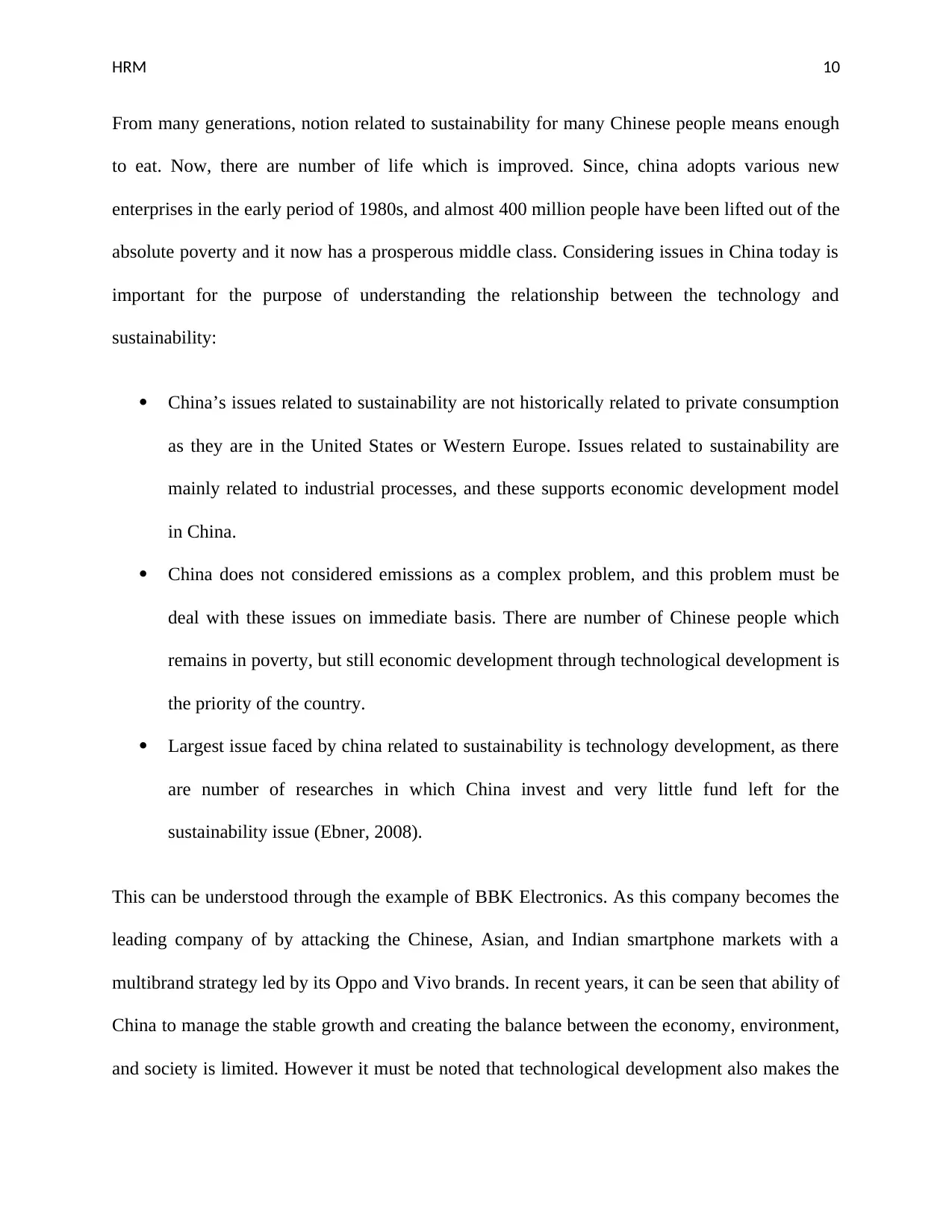
HRM 10
From many generations, notion related to sustainability for many Chinese people means enough
to eat. Now, there are number of life which is improved. Since, china adopts various new
enterprises in the early period of 1980s, and almost 400 million people have been lifted out of the
absolute poverty and it now has a prosperous middle class. Considering issues in China today is
important for the purpose of understanding the relationship between the technology and
sustainability:
China’s issues related to sustainability are not historically related to private consumption
as they are in the United States or Western Europe. Issues related to sustainability are
mainly related to industrial processes, and these supports economic development model
in China.
China does not considered emissions as a complex problem, and this problem must be
deal with these issues on immediate basis. There are number of Chinese people which
remains in poverty, but still economic development through technological development is
the priority of the country.
Largest issue faced by china related to sustainability is technology development, as there
are number of researches in which China invest and very little fund left for the
sustainability issue (Ebner, 2008).
This can be understood through the example of BBK Electronics. As this company becomes the
leading company of by attacking the Chinese, Asian, and Indian smartphone markets with a
multibrand strategy led by its Oppo and Vivo brands. In recent years, it can be seen that ability of
China to manage the stable growth and creating the balance between the economy, environment,
and society is limited. However it must be noted that technological development also makes the
From many generations, notion related to sustainability for many Chinese people means enough
to eat. Now, there are number of life which is improved. Since, china adopts various new
enterprises in the early period of 1980s, and almost 400 million people have been lifted out of the
absolute poverty and it now has a prosperous middle class. Considering issues in China today is
important for the purpose of understanding the relationship between the technology and
sustainability:
China’s issues related to sustainability are not historically related to private consumption
as they are in the United States or Western Europe. Issues related to sustainability are
mainly related to industrial processes, and these supports economic development model
in China.
China does not considered emissions as a complex problem, and this problem must be
deal with these issues on immediate basis. There are number of Chinese people which
remains in poverty, but still economic development through technological development is
the priority of the country.
Largest issue faced by china related to sustainability is technology development, as there
are number of researches in which China invest and very little fund left for the
sustainability issue (Ebner, 2008).
This can be understood through the example of BBK Electronics. As this company becomes the
leading company of by attacking the Chinese, Asian, and Indian smartphone markets with a
multibrand strategy led by its Oppo and Vivo brands. In recent years, it can be seen that ability of
China to manage the stable growth and creating the balance between the economy, environment,
and society is limited. However it must be noted that technological development also makes the
Secure Best Marks with AI Grader
Need help grading? Try our AI Grader for instant feedback on your assignments.
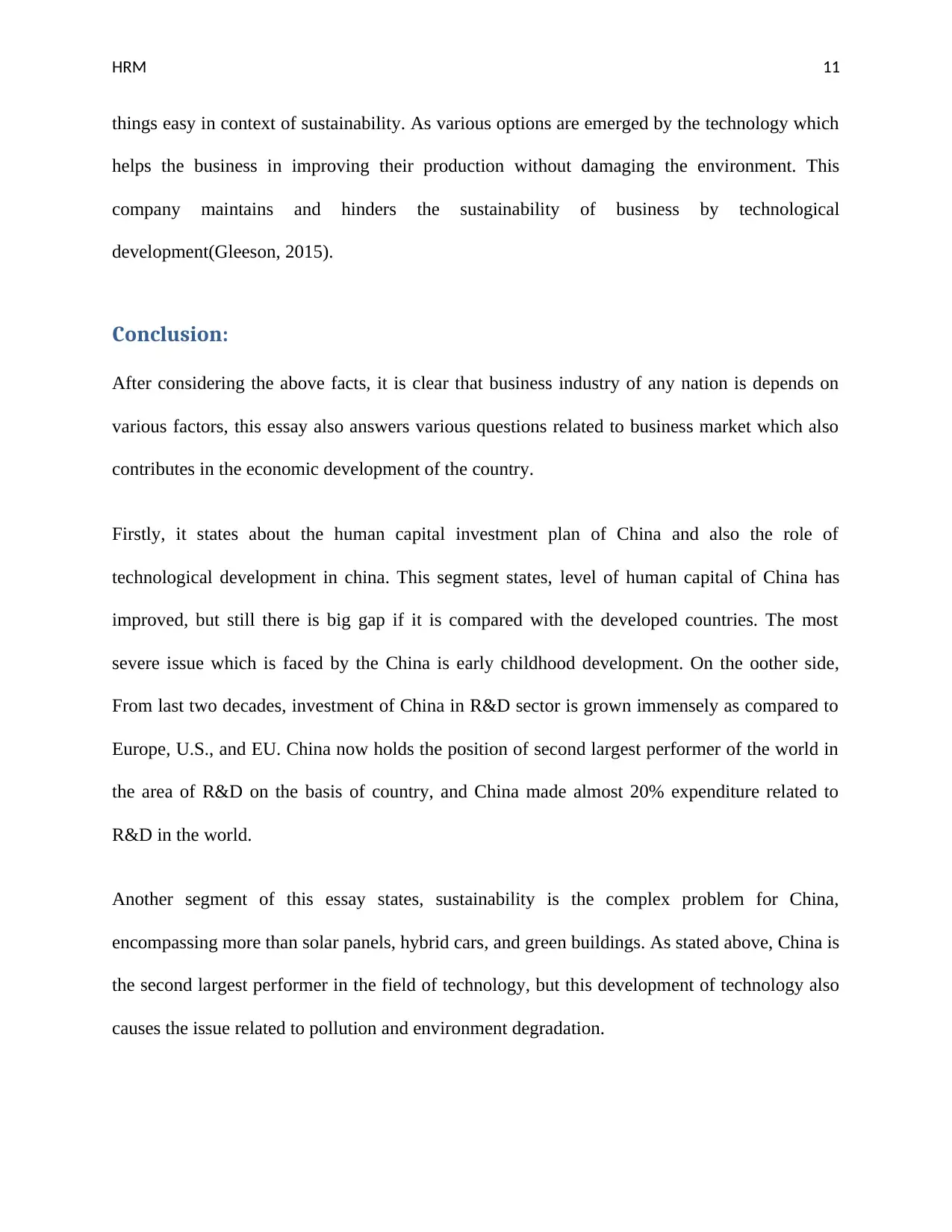
HRM 11
things easy in context of sustainability. As various options are emerged by the technology which
helps the business in improving their production without damaging the environment. This
company maintains and hinders the sustainability of business by technological
development(Gleeson, 2015).
Conclusion:
After considering the above facts, it is clear that business industry of any nation is depends on
various factors, this essay also answers various questions related to business market which also
contributes in the economic development of the country.
Firstly, it states about the human capital investment plan of China and also the role of
technological development in china. This segment states, level of human capital of China has
improved, but still there is big gap if it is compared with the developed countries. The most
severe issue which is faced by the China is early childhood development. On the oother side,
From last two decades, investment of China in R&D sector is grown immensely as compared to
Europe, U.S., and EU. China now holds the position of second largest performer of the world in
the area of R&D on the basis of country, and China made almost 20% expenditure related to
R&D in the world.
Another segment of this essay states, sustainability is the complex problem for China,
encompassing more than solar panels, hybrid cars, and green buildings. As stated above, China is
the second largest performer in the field of technology, but this development of technology also
causes the issue related to pollution and environment degradation.
things easy in context of sustainability. As various options are emerged by the technology which
helps the business in improving their production without damaging the environment. This
company maintains and hinders the sustainability of business by technological
development(Gleeson, 2015).
Conclusion:
After considering the above facts, it is clear that business industry of any nation is depends on
various factors, this essay also answers various questions related to business market which also
contributes in the economic development of the country.
Firstly, it states about the human capital investment plan of China and also the role of
technological development in china. This segment states, level of human capital of China has
improved, but still there is big gap if it is compared with the developed countries. The most
severe issue which is faced by the China is early childhood development. On the oother side,
From last two decades, investment of China in R&D sector is grown immensely as compared to
Europe, U.S., and EU. China now holds the position of second largest performer of the world in
the area of R&D on the basis of country, and China made almost 20% expenditure related to
R&D in the world.
Another segment of this essay states, sustainability is the complex problem for China,
encompassing more than solar panels, hybrid cars, and green buildings. As stated above, China is
the second largest performer in the field of technology, but this development of technology also
causes the issue related to pollution and environment degradation.
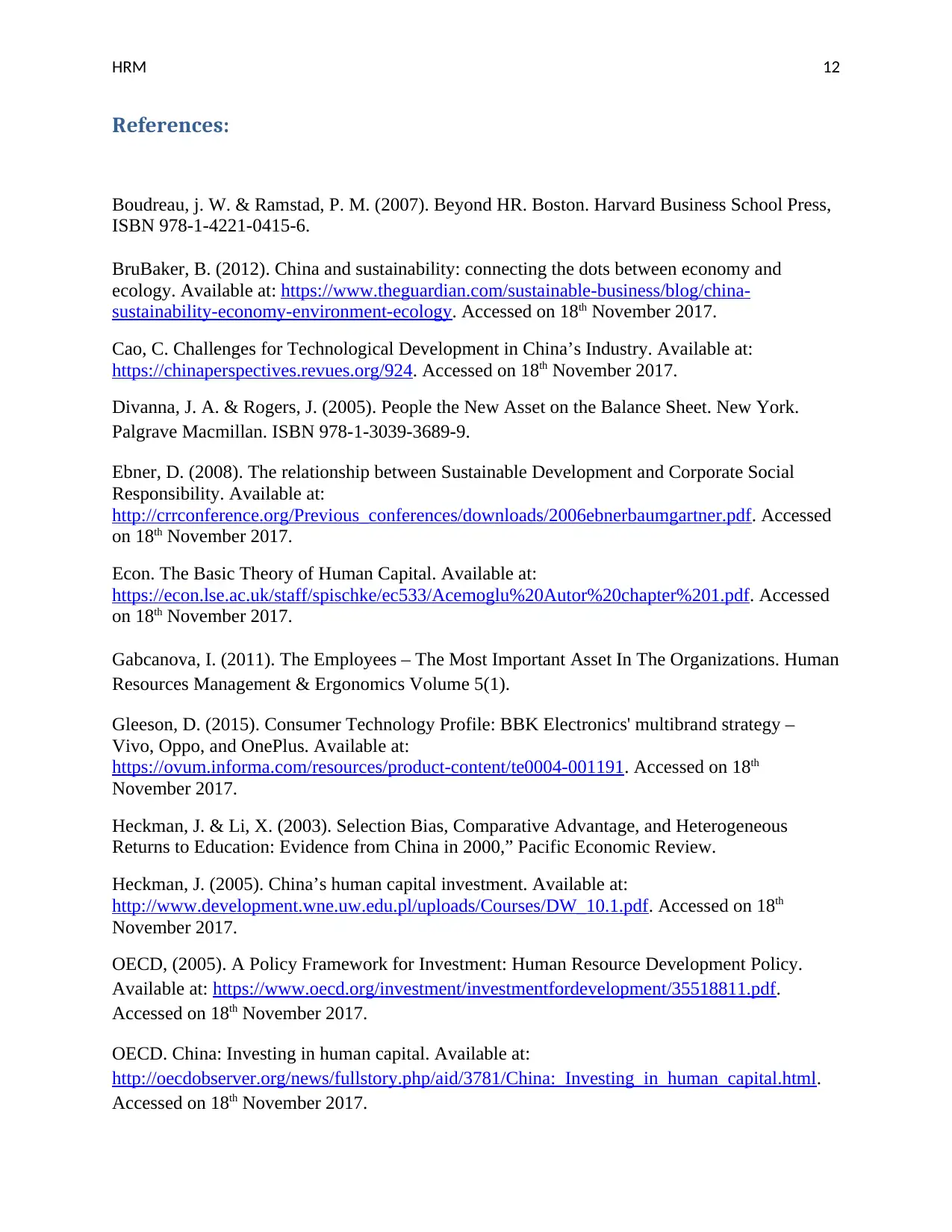
HRM 12
References:
Boudreau, j. W. & Ramstad, P. M. (2007). Beyond HR. Boston. Harvard Business School Press,
ISBN 978-1-4221-0415-6.
BruBaker, B. (2012). China and sustainability: connecting the dots between economy and
ecology. Available at: https://www.theguardian.com/sustainable-business/blog/china-
sustainability-economy-environment-ecology. Accessed on 18th November 2017.
Cao, C. Challenges for Technological Development in China’s Industry. Available at:
https://chinaperspectives.revues.org/924. Accessed on 18th November 2017.
Divanna, J. A. & Rogers, J. (2005). People the New Asset on the Balance Sheet. New York.
Palgrave Macmillan. ISBN 978-1-3039-3689-9.
Ebner, D. (2008). The relationship between Sustainable Development and Corporate Social
Responsibility. Available at:
http://crrconference.org/Previous_conferences/downloads/2006ebnerbaumgartner.pdf. Accessed
on 18th November 2017.
Econ. The Basic Theory of Human Capital. Available at:
https://econ.lse.ac.uk/staff/spischke/ec533/Acemoglu%20Autor%20chapter%201.pdf. Accessed
on 18th November 2017.
Gabcanova, I. (2011). The Employees – The Most Important Asset In The Organizations. Human
Resources Management & Ergonomics Volume 5(1).
Gleeson, D. (2015). Consumer Technology Profile: BBK Electronics' multibrand strategy –
Vivo, Oppo, and OnePlus. Available at:
https://ovum.informa.com/resources/product-content/te0004-001191. Accessed on 18th
November 2017.
Heckman, J. & Li, X. (2003). Selection Bias, Comparative Advantage, and Heterogeneous
Returns to Education: Evidence from China in 2000,” Pacific Economic Review.
Heckman, J. (2005). China’s human capital investment. Available at:
http://www.development.wne.uw.edu.pl/uploads/Courses/DW_10.1.pdf. Accessed on 18th
November 2017.
OECD, (2005). A Policy Framework for Investment: Human Resource Development Policy.
Available at: https://www.oecd.org/investment/investmentfordevelopment/35518811.pdf.
Accessed on 18th November 2017.
OECD. China: Investing in human capital. Available at:
http://oecdobserver.org/news/fullstory.php/aid/3781/China:_Investing_in_human_capital.html.
Accessed on 18th November 2017.
References:
Boudreau, j. W. & Ramstad, P. M. (2007). Beyond HR. Boston. Harvard Business School Press,
ISBN 978-1-4221-0415-6.
BruBaker, B. (2012). China and sustainability: connecting the dots between economy and
ecology. Available at: https://www.theguardian.com/sustainable-business/blog/china-
sustainability-economy-environment-ecology. Accessed on 18th November 2017.
Cao, C. Challenges for Technological Development in China’s Industry. Available at:
https://chinaperspectives.revues.org/924. Accessed on 18th November 2017.
Divanna, J. A. & Rogers, J. (2005). People the New Asset on the Balance Sheet. New York.
Palgrave Macmillan. ISBN 978-1-3039-3689-9.
Ebner, D. (2008). The relationship between Sustainable Development and Corporate Social
Responsibility. Available at:
http://crrconference.org/Previous_conferences/downloads/2006ebnerbaumgartner.pdf. Accessed
on 18th November 2017.
Econ. The Basic Theory of Human Capital. Available at:
https://econ.lse.ac.uk/staff/spischke/ec533/Acemoglu%20Autor%20chapter%201.pdf. Accessed
on 18th November 2017.
Gabcanova, I. (2011). The Employees – The Most Important Asset In The Organizations. Human
Resources Management & Ergonomics Volume 5(1).
Gleeson, D. (2015). Consumer Technology Profile: BBK Electronics' multibrand strategy –
Vivo, Oppo, and OnePlus. Available at:
https://ovum.informa.com/resources/product-content/te0004-001191. Accessed on 18th
November 2017.
Heckman, J. & Li, X. (2003). Selection Bias, Comparative Advantage, and Heterogeneous
Returns to Education: Evidence from China in 2000,” Pacific Economic Review.
Heckman, J. (2005). China’s human capital investment. Available at:
http://www.development.wne.uw.edu.pl/uploads/Courses/DW_10.1.pdf. Accessed on 18th
November 2017.
OECD, (2005). A Policy Framework for Investment: Human Resource Development Policy.
Available at: https://www.oecd.org/investment/investmentfordevelopment/35518811.pdf.
Accessed on 18th November 2017.
OECD. China: Investing in human capital. Available at:
http://oecdobserver.org/news/fullstory.php/aid/3781/China:_Investing_in_human_capital.html.
Accessed on 18th November 2017.
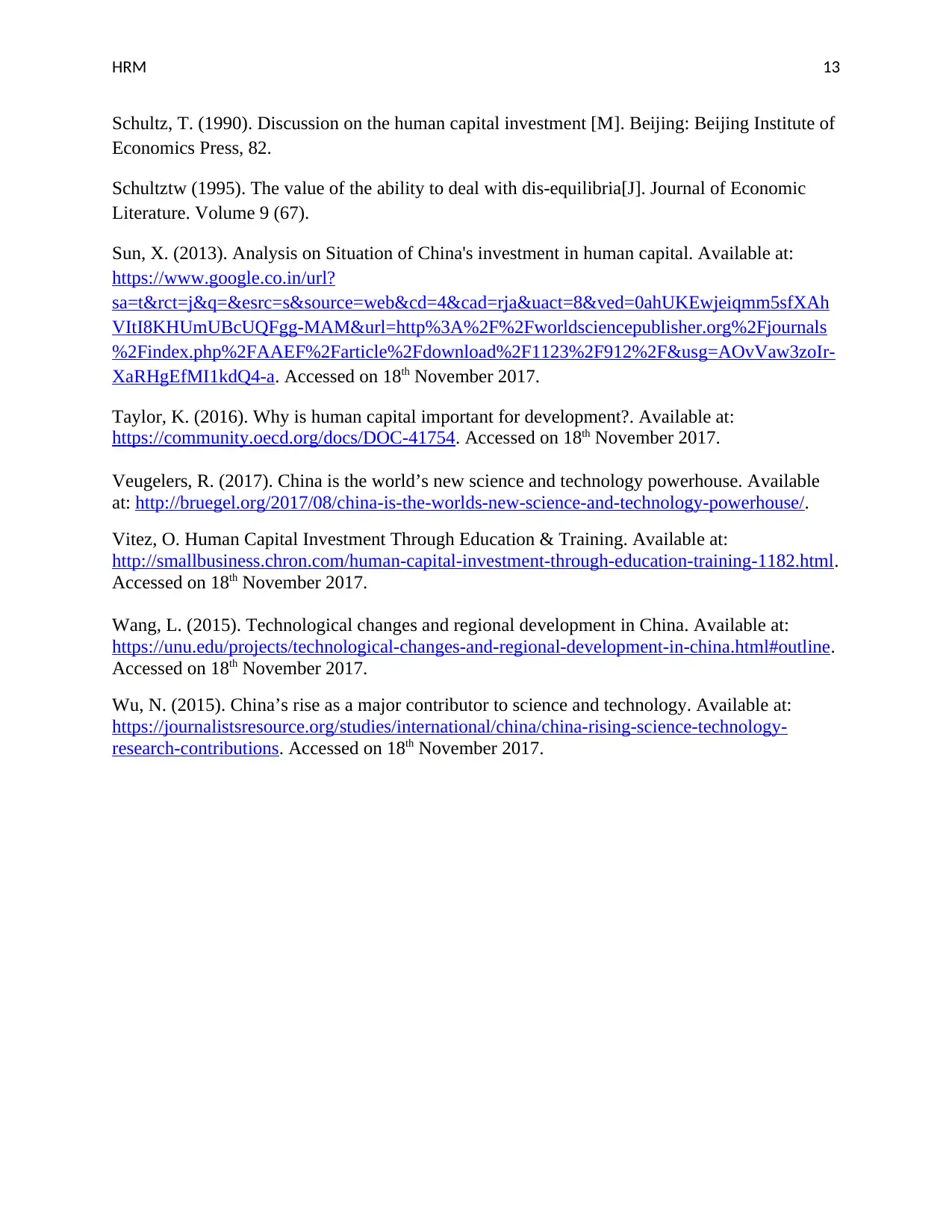
HRM 13
Schultz, T. (1990). Discussion on the human capital investment [M]. Beijing: Beijing Institute of
Economics Press, 82.
Schultztw (1995). The value of the ability to deal with dis-equilibria[J]. Journal of Economic
Literature. Volume 9 (67).
Sun, X. (2013). Analysis on Situation of China's investment in human capital. Available at:
https://www.google.co.in/url?
sa=t&rct=j&q=&esrc=s&source=web&cd=4&cad=rja&uact=8&ved=0ahUKEwjeiqmm5sfXAh
VItI8KHUmUBcUQFgg-MAM&url=http%3A%2F%2Fworldsciencepublisher.org%2Fjournals
%2Findex.php%2FAAEF%2Farticle%2Fdownload%2F1123%2F912%2F&usg=AOvVaw3zoIr-
XaRHgEfMI1kdQ4-a. Accessed on 18th November 2017.
Taylor, K. (2016). Why is human capital important for development?. Available at:
https://community.oecd.org/docs/DOC-41754. Accessed on 18th November 2017.
Veugelers, R. (2017). China is the world’s new science and technology powerhouse. Available
at: http://bruegel.org/2017/08/china-is-the-worlds-new-science-and-technology-powerhouse/.
Vitez, O. Human Capital Investment Through Education & Training. Available at:
http://smallbusiness.chron.com/human-capital-investment-through-education-training-1182.html.
Accessed on 18th November 2017.
Wang, L. (2015). Technological changes and regional development in China. Available at:
https://unu.edu/projects/technological-changes-and-regional-development-in-china.html#outline.
Accessed on 18th November 2017.
Wu, N. (2015). China’s rise as a major contributor to science and technology. Available at:
https://journalistsresource.org/studies/international/china/china-rising-science-technology-
research-contributions. Accessed on 18th November 2017.
Schultz, T. (1990). Discussion on the human capital investment [M]. Beijing: Beijing Institute of
Economics Press, 82.
Schultztw (1995). The value of the ability to deal with dis-equilibria[J]. Journal of Economic
Literature. Volume 9 (67).
Sun, X. (2013). Analysis on Situation of China's investment in human capital. Available at:
https://www.google.co.in/url?
sa=t&rct=j&q=&esrc=s&source=web&cd=4&cad=rja&uact=8&ved=0ahUKEwjeiqmm5sfXAh
VItI8KHUmUBcUQFgg-MAM&url=http%3A%2F%2Fworldsciencepublisher.org%2Fjournals
%2Findex.php%2FAAEF%2Farticle%2Fdownload%2F1123%2F912%2F&usg=AOvVaw3zoIr-
XaRHgEfMI1kdQ4-a. Accessed on 18th November 2017.
Taylor, K. (2016). Why is human capital important for development?. Available at:
https://community.oecd.org/docs/DOC-41754. Accessed on 18th November 2017.
Veugelers, R. (2017). China is the world’s new science and technology powerhouse. Available
at: http://bruegel.org/2017/08/china-is-the-worlds-new-science-and-technology-powerhouse/.
Vitez, O. Human Capital Investment Through Education & Training. Available at:
http://smallbusiness.chron.com/human-capital-investment-through-education-training-1182.html.
Accessed on 18th November 2017.
Wang, L. (2015). Technological changes and regional development in China. Available at:
https://unu.edu/projects/technological-changes-and-regional-development-in-china.html#outline.
Accessed on 18th November 2017.
Wu, N. (2015). China’s rise as a major contributor to science and technology. Available at:
https://journalistsresource.org/studies/international/china/china-rising-science-technology-
research-contributions. Accessed on 18th November 2017.
1 out of 13
Related Documents
Your All-in-One AI-Powered Toolkit for Academic Success.
+13062052269
info@desklib.com
Available 24*7 on WhatsApp / Email
![[object Object]](/_next/static/media/star-bottom.7253800d.svg)
Unlock your academic potential
© 2024 | Zucol Services PVT LTD | All rights reserved.




